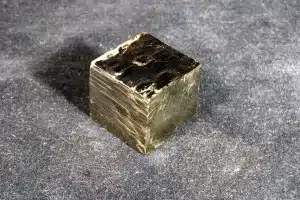
Three billion years ago the Earth couldn’t support life as we know it – the atmosphere was deadly to oxygen-breathing plants and animals.
But two and half billion years ago life changed the Earth’s atmosphere creating the oxygen-rich air we rely on today.
How this ‘Great Oxidation’ happened is one of the greatest questions of evolution. And the answer will also contribute to the search for extraterrestrial life and for new mineral deposits.
“We have discovered new ways to use fool’s gold to reconstruct the ancient atmosphere,’ says Michaela Partridge, a PhD student at the University of Queensland.
“Some fool’s gold, or pyrite, is made by microbes We’ve found that as the concentration of sulfur and oxygen in the atmosphere changes we find differently-shaped grains of the bright golden sulfur-bearing mineral pyrite or fool’s gold in the rock record. We can then work out which of these grains were made by simple organisms and which were formed by inorganic processes.
“By analysing these tiny golden mineral grains we can build much more detailed models of the ancient biosphere and atmosphere.” says Michaela, one of the primary researchers involved in the project.
Aspects of the research have been published in the prestigious scientific journal Earth and Planetary Science Letters.
The UQ team, led by A/Prof Sue Golding in the School of Earth Sciences, is the first to confirm that differently shaped grains of pyrite may originate from different sulfur sources. The two to three-billion-year-old rocks studied by the team are from Western Australia’s Hamersley Basin and can contain several different forms of pyrite which microscopic organisms helped to produce.
“We can analyse the chemistry of both the pyrite and the rock itself to discover if any organisms were present, and if they were, whether they lived in a high or low oxygen environment.” says Michaela Partridge. We’ve found that there were locally different ‘pools’ of sulfur in the atmosphere and oceans two and a half billion years ago. This can only happen under conditions of low oxygen.
“We have already found that life on Earth three billion years ago was much more complex than previously thought. There were many different communities of bacteria, blue green algae and other microbes. ”
Mapping the changes of when and where different types of microbes existed allows the team to trace the spread of oxygen from low concentrations in localised environments three billion years ago, to the oxygen-rich planet we know today. The researchers have shown that these changes happened much more slowly than previous models have suggested.
This understanding of the early evolution of planet Earth will help to extend what we know about the life forms and atmospheres that might evolve on other planets and moons, in our own solar system and beyond.
And, this early life on Earth contributed to the creation of some of the richest mineral resources in Australia so there may be benefits for mineral exploration.
Michaela Partridge is one of 15 early-career scientists presenting their research to the public for the first time thanks to Fresh Science, a national program sponsored by the Federal Government.
For further information, contact Michaela Partridge 07 3365 2166, 0405 122 752, m.partridge@uq.edu.au), Sue Golding 07 3365 1159, email s.golding@earth.uq.edu.au, Andrew Dunne at UQ Communications 07 3365 2802).
Hi-res images and video footage of UQ researchers working in the Hamersley region are available by contacting UQ Photographic Librarian Karen Poole (+61 7 3365 2753).
Header Image: Pyrite specimen- though not one created by microbial action (credit: National Biological Information Infrastructure, photograher: Bruce Avera Hunter)
For Fresh Science contact: Sarah Brooker on 0413 332 489 and Niall Byrne on 0417 131 977 or niall@freshscience.org. Background information at www.freshscience.org.
Background Information
The Archean-Proterozoic boundary, some 2.5 billion years (Ga) ago, marks a significant period of Earth’s history when the atmosphere and oceans transformed from oxygen-poor to more oxygen-rich conditions over a relatively short period of time. The carbon and sulfur isotope record in rocks formed at this time is of considerable importance because it provides evidence for changes in early Earth’s atmospheric oxygen levels. These changes can potentially constrain the origin and relative impact of various microbial metabolisms during the transition from an anoxic to oxic atmosphere. The purpose of the UQ research is to use chemical footprints left behind in the rock record to determine what kinds of organisms were active during this so-called ‘Great Oxygenation Event’.
Some organisms use different forms of carbon and sulfur, called isotopes, in quite specific ways. The effects of some of these metabolic processes can be preserved in sulfur bearing minerals and carbon-rich rocks, even for billions of years. This means that isotopes can be used like chemical fossils to determine not just when and where particular microbes were active, but also what sort of environment they lived in, and even what the composition of the atmosphere was at the time. The results of the UQ research demonstrate how effectively carbon and sulfur isotopes can be combined to track changes in microbial abundances and habitats over geological time.
Sulfur isotope values in late Archean pyrite vary according to the shape of individual mineral grains. Sulfur isotopes in extremely small grains of pyrite indicate a reduced elemental sulfur source in a low oxygen environment, whereas larger pyrite nodules were potentially derived from more soluble sulfate through microbial activity in a more oxidised environment. In the early Paleoproterozoic, sulfur isotope distributions indicate that isolated deeper water hydrothermal environments remained anoxic while shallower water environments became more oxidised.
The Hamersley Basin, located in NW Western Australia is an excellent region in which to study Archean and Paleoproterozoic rocks as it provides a relatively uninterrupted geologic record of the time, and preserves a diverse range of depositional environments. While the Hamersley Basin has been extensively studied, many previous investigations using sulfur isotopes to learn about early life on Earth relied on much more time consuming and less detailed analytical methods than the technique used by the UQ team that was developed at the University of Queensland Stable Isotope Laboratory by Kim Baublys, Elisa Young and Sue Golding. [Baublys et al., R. Commun. Mass Spect. 18 (2004) 2765-2769].
This research was partially funded by an Australian Research Council Discovery grant awarded to Dr Sue Golding.






 Fresh Science is on hold for 2022. We will be back in 2023.
Fresh Science is on hold for 2022. We will be back in 2023.